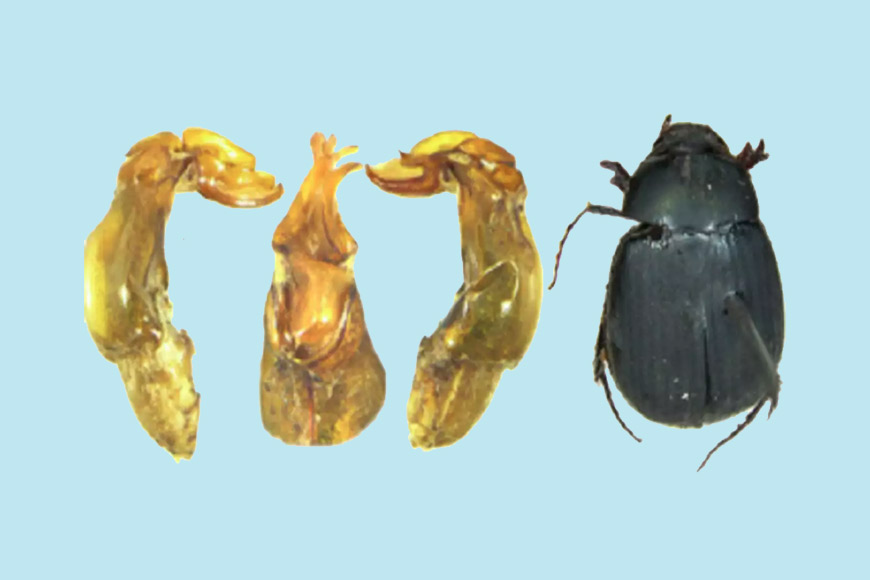New beetle discovered in Behala: An interview with Zoology head of Ballygunge Science College - GetBengal story

The Zoological Survey of India (ZSI) scientists have been researching the Sericini species of beetle since 2019. Sericini, incidentally, is a tribe of scarab beetles in the family Scarabaeidae. There are at least 100 described species in Sericini. Recently, ZSI scientists Kolkata along with scientists from the Department of Zoology, Kalyani University, and Germany's Alexander Koenig Leibniz Institute discovered a new species of leaf-eating beetle (phytophagus beetle) from Behala region of south Kolkata. Phytophagous insects are those that feed on green plants using smell to locate the host plants. They attack roots, stems, leaves and fruits either as larvae or as adults or in both stages. The newly discovered beetle has been christened 'Maladera Kolkataensis' Bhuinya, Gupta, Sarkar and Ahrens-2023. The last four surnames denote the scientists associated with the study, namely, Devika Bhuinya, Devanshu Gupta, Subhankar Kumar Sarkar and Dirk Ahrens.
The family Scarabaeidae consists of over 35,000 species of beetles worldwide; they are called scarabs or scarab beetles. For the ancient Egyptians, scarab species were considered a holy symbol of resurrection. According to Egyptian spiritual belief, sunrays radiated from the head of scarab and its dung ball was the whole world, caught in an eternal cycle of daily renewal foundation that leads to a greatly sustainable system. However, the big question is why are entomologists so intent on studying scarab beetles?
 Professor Ena Ray Banerjee, Head of the Zoology Department, University of Calcutta
Professor Ena Ray Banerjee, Head of the Zoology Department, University of Calcutta
Eminent immunologist and regenerative biologist, Professor Ena Ray Banerjee, who is currently the head of the Zoology department, University of Calcutta, elucidated the reasons. “The evolution of scarab beetles is important for the study of biodiversity. Biodiversity or biological diversity is, as we know, the variety and variability of life on Earth. Biodiversity is a measure of variation at the genetic, species, and ecosystem level. A living organism interacts or communicates with the environment for survival but if there is a change in the environment, the organism fails to interpret or interact with the altered environment. Diversity is important for transduction of environmental stimuli.”
She continues, “Our survival index is determined by the right atmospheric conditioning where we can dwell. The prime need for diversity is when the climatic conditions keep changing. The survival of any form of life depends on a very complex food chain and whenever there is a climatic shift, which is occurring incessantly, we observe many species becoming extinct and many new species emerging. When there is more diversity, it ensures a greater chance of survival through assimilation or what we call decodifying, despite a shift in the environmental factors. From our point of view, we depend on a very complex network of information that has been transfused by other forms of life and non-life like light, air, temperature etc. The speciation is a continuous process and those who fall within the survivality index they survive, but those who can’t, ‘miss the bus’ and perish.
The Phytophagus beetle that was discovered recently does not indicate that it did not exist. It is possible that the species existed but was not characterized using certain technological tools that are available now and it could also be a new species that has emerged out of micro evolution at the lower level and it can be due to competitive exclusion by other species. Beetles have a hard outer shell and they have unique characteristics: they are scavengers as well as leaf or plant eaters and feed on feces. Energy is transacted through a complex network in these species, some of the transude forms we can process and some we can’t. Those which we cannot, remain in the intermediate stage of this complex food chain who process them anyway for other forms of life. There are layers of relationships involved in this processing which is called commensalism/parasitism/mutualism that is an association between two organisms in which one benefits and the other derives neither benefit nor harm. It is possible that there has been a requirement for a new form of ecosystem energy and this new species of beetle is conducive to the energy transmission project. The entire ecosystem is like an organism and as the Gaia hypothesis proposes that living organisms interact with their inorganic surroundings on Earth to form a synergistic and self-regulating, complex system that helps to maintain and perpetuate the conditions for life on the planet. Here the beetle, a living entity, compliments the ecosystem.”
Also read : Rare ghost fungus spotted in Bengal
In other words, the evolution of scarab beetles tracks the sequential rise of angiosperms and mammals. Scarab beetles also known as dung beetles is considered the most significant insect assemblies in the tropical zones because of their vital role in the nutrient recycling, helminthes control and seed dispersion as they use dung of herbivorous and omnivorous mammals as a food reserve. The different species of dung beetles thrive on a wide range of food sources ranging from flesh to dung to more particular sources like mushrooms, diplopods, fruits, eggs, vegetation and detritus.
India has a rich heritage of natural diversity and the Gangetic plain region is one of the 10 bio-geographic regions of India. Scientists are still working to ascertain whether this new species found in the agricultural low Gangetic plains (including West Bengal and Bihar) is beneficial or harmful for humans and vegetation. Though, varied aspects of the ecological history of dung beetles have been extensively studied, little is recognized about their particular use of different dung beetles in multiple nutrients cycles such as nitrogen cycle, organic matter decomposition, CH4 emissions, NH3 volatilization, greenhouse gases emission, waste management, forest and agro pasture ecosystem stability as well as soil and agricultural cycles. This species of phytophagous beetle was first spotted in Behala area survey in 1984.This specific type of beetle feeds on different parts of plants, although there is no significant report on this insect being a pest.
The Phytophagus beetle that was discovered recently does not indicate that it did not exist. It is possible that the species existed but was not characterized using certain technological tools that are available now and it could also be a new species that has emerged out of micro evolution at the lower level and it can be due to competitive exclusion by other species.
Zoological Survey of India (ZSI) scientists have been researching the Sericini species of beetle since 2019 and they identified this beetle as a new species. Dirk Ahrens of the Alexander Koenig Leibniz Institute in Germany confirmed it in 2021. Devika Bhuinya is a research scholar of the Coleoptera Department of ZSI and Zoology Department of Kalyani University. She recently, published a research paper titled 'A New Species and New Record of Sericini from Lower Gangetic Plain of India' in ‘Zootaxa’ a peer-reviewed international scientific mega journal for animal taxonomists, along with Devanshu Gupta, Officer-in-Charge of Coleoptera Division, Subhankar Kumar Sarkar, head of Zoology Department, Kalyani University and Dirk Ahrens of Alexander Koenig Leibniz Institute, Germany. The team of entomologists also reported having come across 21 new zoological species in West Bengal and Bihar. Out of these, 12 species were found in Bihar and 9 in West Bengal.
Behala was once a part of the Sundarbans and later developed into one of the oldest residential areas. Today, it encompasses one of the largest suburban agglomerations of the city. Huge growth of population especially since the early 1980s resulted in enormous and unplanned growth resulting Behala losing significant amount of open green space over the past few decades. This loss of greenery has also affected the environment and living conditions of all living species including birds, mammals, insects, reptiles and amphibians. Taxonomists are working diligently to fathom the significance of this new beetle. The team has described 11 new species of beetles in various papers. It is reassuring when zoologists insist that despite the fast development and urbanization of Behala, biodiversity is not all lost or dwindling, there is hope and the measures taken by the ministry of environment, forests and climate change (MOEFCC) are bearing fruit. Such biodiversity studies are very much relevant in today's economic context, as both these two states are part of the lower Gangetic plains, which is an epicenter of Indian agriculture. In fact, scientists around the world will appreciate the findings about the taxonomy and evolution of this beetle tribe and hence, this study is very pertinent from the scientific point of view.











